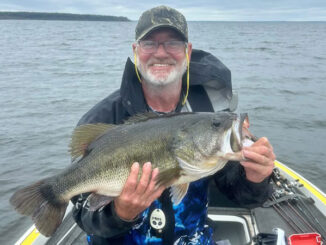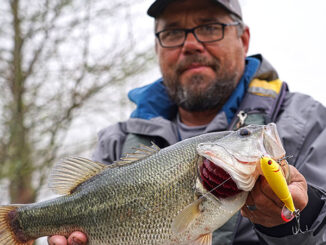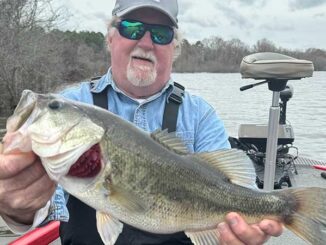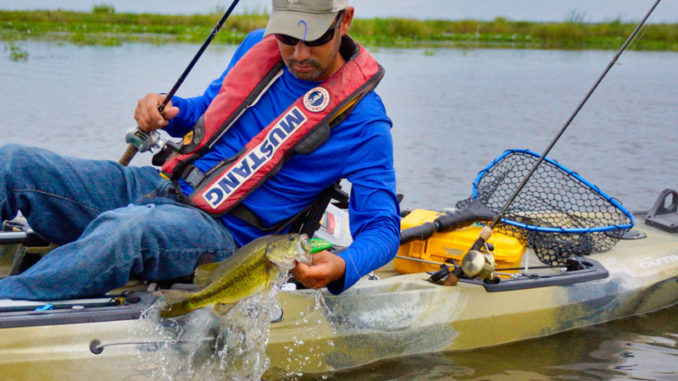
As summer arrives, many freshwaters and brackish waters in Louisiana see a drastic increase in the amount of submerged aquatic vegetation — i.e. grass. No matter what kind, this collective expanse of greenery makes for great, albeit somewhat challenging fishing.
Kayaks are uniquely situated to fish large expanses of grass where powerboats just cannot go. From above, the grass may appear impenetrable, but the fish underneath prove otherwise.
Short of technical poling skiffs, boats with outboard motors and even powerful trolling motors simply cannot efficiently and, more important, quietly traverse the large areas of grass where fish lurk. However, kayaks can easily be paddled or poled across the grass without causing much of a disturbance. If the grass is thick, most pedal-drive kayaks simply need to raise or remove the drive unit so they can be paddled without any resistance or grass fouling.
In freshwater, bass are the primary target. For brackish areas, redfish and bass often frequent the same grass-laden areas and sometimes even speckled trout. All three will viciously strike a good topwater offering, and when the grass is thick, it is hard to beat throwing a weedless frog lure or similar weedless baitfish imitation.
Frog baits
Frog baits come in a variety sizes and shapes. Some are true-to-life replicas with detailed hollow-body shapes and legs, while others are generally frog-shaped with silicone skirts similar to those on a spinnerbait to imitate the frog’s rear legs. The hooks point up and are close to the body to avoid fouling. For heavy grass, the more streamlined baits with silicone legs foul less often.
Setting the hook on a frog bite can be frustrating. Many anglers shy away from using frogs because they miss too many fish. However, with a little change in technique, getting a fish hooked and staying hooked can be greatly increased. Frog bites are explosive, and the natural reaction is to rear back and instantly set the hook. However, this often pulls the lure out of the fish’s mouth without getting connected. It is best not to set the hook instantly when the fish hits the frog. You need to give it a chance to get the frog well down into its mouth. The fish sucks in a lot of water on the strike, and if you set too soon, you more often than not pull the frog out of its mouth before it has a good hold on it.
A second tip is, if you do overreact, and all you get is a frog flying back at the kayak, don’t give up. Quickly reel in and cast back to the exact spot, as chances are the strike may have been just a tail slap or the fish did not feel the hook. Try again, and the next strike may be the one that counts.
Braided line
If you are fishing frogs in heavy cover, be it lily pads or matted grass, use any line as long as it is braid, which has no stretch and helps to drive the hooks home. Also, braid actually slices through the vegetation if the fish wraps you up in a big clump of grass or around a lily pad stem. Avoid using any leader. With the heavy cover, there are no worries of the fish being line shy.
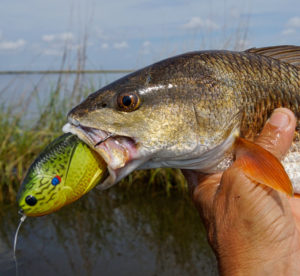
Think like a frog, act like a frog. There are many ways to successfully fish a frog lure, but the best is to make it act froggy. Jump it, sit it still for a while, pull it up onto a stump, lily pad or on top of the grass. Hop it off, twitch it, walk it, but don’t forget to pause it, as that is often when the strikes come. Cast with a high arc so it makes a plop when it hits the water. Shake and move the grass with it. If the lure gets into a patch of open water, make it appear more nervous and eager to get out of the wide open.
Frog-like lures
Other lures with similar construction to frogs are designed to mimic a variety of baitfish. They also have hollow bodies and protected weedless hooks. Rather than swim like a fish, they lay sideways and provide a profile as if they are struggling or dying. They are great for slowly twitching and working in place, particularly at the edge of a grass line or a small clearing in a thick area. Handling the strike is the same as with a frog.
Use the kayak to stealthily move across large expanses of grass, and cast in every direction. Keep an eye out for slight movements in the grass: jumping bait or even a curious bird lurking overhead. Thoroughly fish an area before moving on.
Sometimes a hooked fish gets so tangled in the grass that you cannot reel it in. When this happens, keep a tight line as you move the kayak to the fish. The grass keeps the fish calm, and you can often get close enough to scoop up grass and land the fish.
Trying to fish heavy grass with many conventional lures is almost impossible and certainly frustrating; this is true even with many so-called weedless lures. When the grass is expansive and so matted that there is no way to easily get a lure through it, the best way is to fish on top of it. Rest assured, fish are lurking below, taking advantage of the shade and cover as they traverse unseen channels and clearings. Next time you find yourself in an area that looks impenetrable, don’t get frustrated — get froggy.
